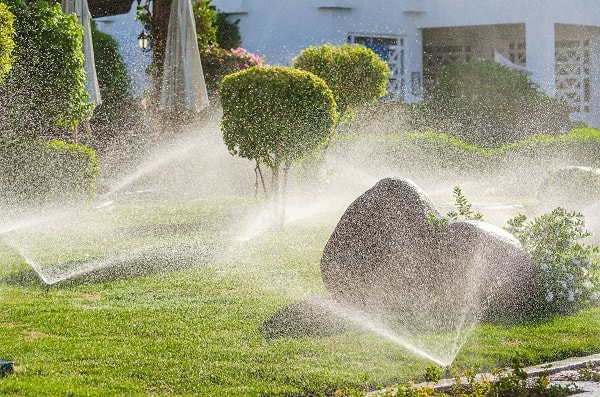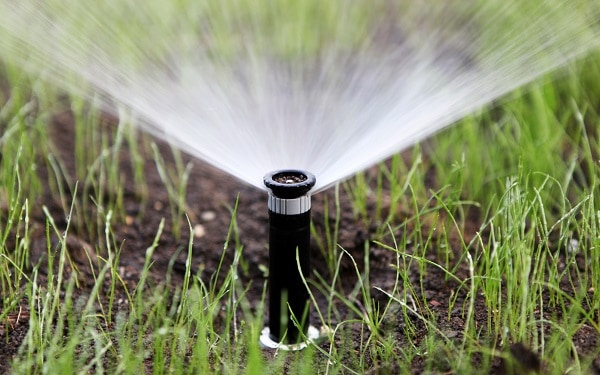
To have a truly vibrant lawn in the Dallas-Fort Worth area, you will have to water it. When it comes to watering your lawn, there is a lot to think about. At what time you should water your lawn might not be something you put much thought into, but it can have a big impact on your grass. In this blog post, HEB Plumbing & Sprinkler will look at what time of day is best to water your lawn, along with other things to keep in mind.
Given the complexity of watering and maintaining a North Texas lawn and all the variables that come with it, it’s best to consult a professional to determine the best practices for your lawn.
Sprinkler Systems

Sprinkler systems make watering your lawn more manageable and can also help water your lawn evenly.
Some popular types of lawn sprinkler systems include:
- Hose-end sprinkler systems: Traditional hose-end sprinklers are the most common type of sprinkler system. There are many types of hose-end sprinklers on the market.
- In-ground sprinkler systems: In-ground sprinkler systems are very efficient; however, they can get expensive.
- Oscillating sprinkler systems: Oscillating sprinkler systems have a weaker water spray while providing good coverage, making them a good choice for newly seeded grass.
- Pulsating sprinkler systems: Pulsating sprinkler systems spray out a strong stream of water vertically, thereby covering a large area. Please note that the pulsating may be too strong for lawns that have newly sodded or seeded grass or other sensitive areas.
Sprinkler System Operation
More complex sprinkler systems are programmed via a controller—often placed in a machine room, basement, or garage because of its delicate electronics.
A controller “tells” a sprinkler when to water a lawn, where to water it, and what the water flow rate should be. It does this by signaling to the valves to tell them when they need to open up and by how much.
Sprinkler System Maintenance
To keep your lawn sprinkler system functioning effectively, you need to perform regular maintenance tasks.
Monthly System Inspection
Inspect your sprinkler system monthly. Check for issues like clogged or broken sprinkler heads, leaks, damage caused by lawn care equipment, or incorrect winterization.
Depending on what you find when inspecting your sprinkler system, you may need to clean drip irrigation filters or clogged screens.
Sprinkler Head Adjustments
When inspecting your sprinkler heads, be sure to remove any obstructions that prevent the water from flowing evenly.
Make any needed adjustments to the position of the sprinkler heads and the spray patterns to avoid watering structures, sidewalks, roads, or driveways. You may also need to adjust sprinklers to compensate for the growth of plants.
Please be aware sprinkler water on roads can lead to dangerous conditions.
Inspect the Water Pressure
The water pressure your sprinkler produces can change over time. When you regularly check the pressure, you can ensure your sprinkler system is operating effectively.
Why Does Timing Matter?
When it comes to watering your lawn, timing makes a difference. Watering your lawn at midday or the afternoon will cause a lot of the water to evaporate, as the temperature is at its warmest during those times.
Do not water your grass at night. This can result in moisture staying on your grass overnight, increasing its disease susceptibility.
When is the Best Time to Water Grass?
The ideal time to water grass is at sunrise. The cooler temperature means the ground will allow for maximum water absorption. The better the water is absorbed into the ground, the less of it is lost to condensation.
When you water your grass at sunrise, you also reduce the likelihood of fungus and other diseases forming.
The next best time to water your grass is in the evening when the sun is less intense, but finish watering at least a half hour before sunset. At this time, the effects of the sun are less harsh, and the temperature cools down, leading to less water evaporating.
Please be aware that the optimal time to water your grass may vary depending on the type of grass you have, the climate where you live, and when the sun rises and sets where you live.
Factors to Consider When Watering Your Grass
There are a number of factors to keep in mind when determining how much and how often you’ll need to water your grass.
Age of Grass
The age of the grass is a factor that influences how much you’ll need to water your lawn.
Grown Lawns
Typically, for a grown lawn, the top six to eight inches of soil should be moist. However, it should not be soggy. To achieve this, you’ll water one inch to an inch and a half a week. For the majority of the year, the watering can be done twice weekly. You can also water it three times a week during the hotter seasons.
Newly Sodded or Seeded Lawns
If your grass has recently been sodded or seeded, it will require moisture in its top inch of soil—but not enough to make it soggy.
Use a mister to gently spray water on the newly planted grass once or twice a day.
Ensure the top two inches of soil are moist when the seeds are germinating.
When the grass reaches a mowing height of three inches, you’ll be able to water just twice a week. Then you’ll be able to soak the soil down to six to eight inches as you would with a lawn that is grown.
Type of Grass
Different types of grass have different watering needs.
Cool Season Grasses
Cool season grasses include rye, fescue, bluegrass, and more. Cool season grasses begin to grow when the soil temperatures get to be around 40 to 60 degrees Fahrenheit. They grow the most during the spring and fall. Generally, cool season grasses will require around one inch of water a week. You can do this by watering the grass three times a week in consistent intervals.
Warm Season Grasses
St. Augustine, bermuda, zoysia, centipede grass, and other warm season grasses do the majority of their growing during summer. For the most part, warm season grasses need less water than cool season grasses, but they too need extra water in extreme heat. These types of grasses generally only need to be watered once or twice a week. These types of grasses only need half an inch to an inch of water each week.
By knowing the type of grass in your yard, you can determine how best to water it. Talk with a landscaping professional or a nearby nursery to determine what type of grass your lawn has.
Climate
Depending on what type of climate you live in, you’ll need to vary how much you water your lawn accordingly.
In climates on the hotter and drier side, you might have to water your lawn more often than you would in a climate that is wetter and cooler.
Your local weather conditions also play a large role in how you water your lawn.
Soil Type
Soil is another factor you need to consider when determining how much and how often to water your lawn.
Generally, you’ll need to water sandy soil more frequently as it drains faster.
On the other hand, with clay soil, you’ll often have to water it less as clay soil does a good job of retaining water.
To best understand how to water your lawn, you should perform a soil test. Doing this will give you insight into your soil’s pH balance and nutrient levels.
How Often Should I Water My Grass?

Finding the right balance between underwatering and overwatering your grass is crucial. As with underwatering your grass, overwatering it can be detrimental as well.
While underwatering your lawn can cause it to go dormant and die out, overwatering your lawn can result in shallow root growth and make them susceptible to diseases.
For the most part, you’ll want to water your lawn infrequently and deeply, as opposed to often and shallowly. By doing this, deeper root growth is encouraged, and it helps the grass to be more resistant to droughts.
Please be advised that how much watering is needed depends on what season it is. When the weather is hot and dry, your lawn may require more watering so it doesn’t dry out. If the weather is wetter and cooler, you may have to water your lawn less frequently to prevent it from becoming oversaturated.
A number of signs can indicate if your grass needs water. For example, if your grass blades are curled or a shade of gray, they require water. By utilizing the simple “step test,” you can determine if your lawn has enough water. If you step on your grass and it stands right back up, it is in good shape.
HEB Plumbing and Sprinkler Sprinkler Repairs
When it comes to ensuring your sprinkler is functioning at its best, turn to the professionals at HEB Plumbing & Sprinkler. We’ve been repairing sprinklers in the Tarrant County, Texas, area for over 40 years and have the know-how to help you get the most out of yours.
Along with sprinkler systems, our woman-owned business also handles plumbing repairs and sewer and drain cleaning.
HEB Plumbing & Sprinkler has won multiple awards and is proud to be a Better Business Bureau-accredited business.
We look forward to helping you keep your sprinkler working great. Contact us to schedule an appointment!
